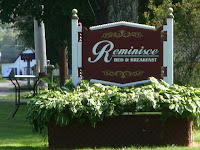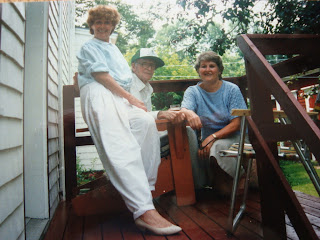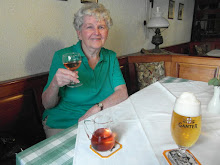For nature lovers and campers, there is a campsite (shown below) directly in Bridgetown along the Annapolis River, as well as one on the crest of North Mountain, in Valleyview Provincial Park, between the Bay of Fundy and town.
 The summer festivals bring tourists, many of them filling the campsite. As well, the town has several bed and breakfasts, a motel in the heart of Bridgetown and a motel with cabins close to the crossroads of Highway 201, on the southern edge of town.
The summer festivals bring tourists, many of them filling the campsite. As well, the town has several bed and breakfasts, a motel in the heart of Bridgetown and a motel with cabins close to the crossroads of Highway 201, on the southern edge of town. Harrington House on Granville Street

Reminisce Bed and Breakfast, on the road leading south over the bridge
Jubilee Park--located on the western side of Bridgetown but still near the center of town--is under construction and renovation, but it is still accessible. It should be completed before next summer.

 I spent some time this past summer talking to the pleasant young woman in the small tourist bureau and visiting the park. It lies along the Annapolis River just off Granville Street West and is a lovely spot for a picnic, for a stroll or just to sit beside the water. A pathway takes you directly into the main part of town, about a five-minute walk or so.
I spent some time this past summer talking to the pleasant young woman in the small tourist bureau and visiting the park. It lies along the Annapolis River just off Granville Street West and is a lovely spot for a picnic, for a stroll or just to sit beside the water. A pathway takes you directly into the main part of town, about a five-minute walk or so.An old-timers' car show takes place here each summer, as well as festivals. The Cider Fest was in mid September, which I missed by a day. The cider itself, though, is pretty mild. You likely won't find any with alcohol, unless a tent is erected, or perhaps at night in the arena. Unlike Europe, no alcohol will be found along the street in booths. The fest itself, though, is fun and a lot of work goes into it. July 1st celebrations include a great fireworks display that night. Another fest takes place on the August 1st weekend.
The above sign likely now reads "Welcome Back!" Education-wise, Bridgetown has a high school and an elementary school. (Within a twenty-minute drive, there are two community colleges, one in Lawrencetown and one in Middleton. Acadia University in Wolfville is about an hour's drive east. Nova Scotia has always deemed education to be important, with several universities in a province of less than one million people.

The above sign likely now reads "Welcome Back!" Education-wise, Bridgetown has a high school and an elementary school. (Within a twenty-minute drive, there are two community colleges, one in Lawrencetown and one in Middleton. Acadia University in Wolfville is about an hour's drive east. Nova Scotia has always deemed education to be important, with several universities in a province of less than one million people.
The high school is below left; the elementary, on the right

Queen Street (shown left and right; the northern end is in the forefront), named after Queen Victoria, is the

 main shopping area in town and is an historic street, with many buildings from the early to late 1800s. As you turn left onto Queen from Albert Street (far end), you can see the pattern that Captain Crosskill created in 1821. Almost all of the original boundaries remain, although the majority of the 90 x 90 foot lots have been divided.
main shopping area in town and is an historic street, with many buildings from the early to late 1800s. As you turn left onto Queen from Albert Street (far end), you can see the pattern that Captain Crosskill created in 1821. Almost all of the original boundaries remain, although the majority of the 90 x 90 foot lots have been divided. The Bank of Nova Scotia, on the corner of Queen and Granville Streets (shown at left), was present in town before 1900, built by local dentists of the time. It is on the site of a tavern and an inn, where, in 1824 at a meeting, the name of the town was chosen. It was also where the stage coach stopped for many years.
The Bank of Nova Scotia, on the corner of Queen and Granville Streets (shown at left), was present in town before 1900, built by local dentists of the time. It is on the site of a tavern and an inn, where, in 1824 at a meeting, the name of the town was chosen. It was also where the stage coach stopped for many years.At that same intersection, just across the street, is The Royal Bank (above right). It has been on this site since 1910, although the present building is only a little over 60 years old.
The two pictures below are of The End of the Line Pub. The end wall of the train station/pub was painted by an artist in the town.
The End of the Line Pub is past the bridge, heading south. This was the town train station for many years. I took this train a couple of times from Bridgetown to Halifax, where it pulled into the city station next to the Nova Scotian Hotel. Most of the train tracks across Canada were removed, leaving only main lines now running across the country.



 Our friends the Nashes from Chester, on Nova Scotia's South Shore, and the Kranabetters from Nürnberg, Germany inside the pub this past summer. One of the things I always order not long after I arrive in Nova Scotia is a hot turkey sandwich. It isn't fancy and it is full of calories, but I like it. It is not something one will find in a German Gasthaus, so I always look forward to it. This is one of my Canadian weaknesses!
Our friends the Nashes from Chester, on Nova Scotia's South Shore, and the Kranabetters from Nürnberg, Germany inside the pub this past summer. One of the things I always order not long after I arrive in Nova Scotia is a hot turkey sandwich. It isn't fancy and it is full of calories, but I like it. It is not something one will find in a German Gasthaus, so I always look forward to it. This is one of my Canadian weaknesses!Rosi and Dieter on the pub deck on another occasion this past summer
There is also a small chicken take-out with a few tables and a pizza place for take-out as well. You have to leave town to find a restaurant.
The town center has several businesses, including a drugstore, hardware store and supermarket, but to find a good clothing store, one must head to New Minas or Halifax. The variety store does carry some clothing.
The Liquor Commission, for wine, beer and spirits, is now situated in the same building as the supermarket, which, for us--and likely most others--is convenient.
Below, a few of the services:


The post office is one of the gathering places and whenever you go there to pick up mail or to send off a letter, you will likely see people having a discussion or two.


Two of my favourite stops in any town, the town library and the secondhand book store.
The most striking of all in Bridgetown are the beautiful homes that line the streets, the majority of them built in the 1800s and early 1900s. Here are a few of them.





My father spent the last ten years of his life in Bridgetown, all but a year of it in the Victorian house on Granville Street with my sister Paula and Laurie, where he had his own suite with a veranda, built onto the house for him in about 1979. The house itself was built in the 1890s. The two pictures below show the house: the bottom one, a side view, shows the extension at the back where my father lived. The house in those days was white.
I visited that house and Bridgetown many times over the years before coming to spend the summer months at our own place. That is what brought us to Bridgetown, along with the beauty of the area and the friends we had met through Paula and Laurie over the years and, of course, because of Paula and Laurie themselves.
The picture below was taken in 1988 on Dad's small deck, with Dad, my sister Carol and me
The Bay of Fundy is just fifteen to twenty minutes north. This is the view one sees as one comes down the hill on the other side of the North Mountain. This is where the great lobsters come from, freshly gathered from the lobster traps in those deep waters of the bay. My brother-in-law, Laurie, buys lobster fresh out of those cold waters from a fisherman in Hampton, the small village at the end of the road.
All in all, Bridgetown is a great town to bring up children or for anyone craving peace and quiet. No heavy traffic mars it, whether within the town or on the highways beyond it. There is no night life to speak of, so for the younger crowd it likely wouldn't be appealing. After saying that though, many of the young people would like to stay if they could find work. There is little industry now and few jobs, so most have to leave to find work elsewhere. The town is one of Nova Scotia's prettiest with its lovely houses lining not only the main street but many of the side streets as well and with the river meandering through its center. The slogan--The Friendly Town--is as welcoming as its residents, who always have time to say hello.
For those who wish to visit Bridgetown, it is situated about 200 kilometers west of Halifax via highway 101, about a two-hour drive west of the Halifax International Airport.
Note: As with my previous blog post about Bridgetown, some of my information came from those same sources I mentioned: the official Bridgetown website and brochures from Jubilee Park, including the one on "A Walking Tour of the Town of Bridgetown, Nova Scotia."
















































